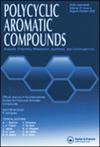调查 Sadhana 和 PI 指数的新方法
IF 2.4
3区 化学
Q2 CHEMISTRY, ORGANIC
引用次数: 0
摘要
拓扑指数是 QSAR 和 QSPR 研究中用来评估图形结构特性的数字。自几年前以来,基于多项式的拓扑指数 Sadhana 和 PI 在化学图论研究中得到了深入探讨。然而,在本研究中,我们采用了一种革命性的瞬时方法来计算六方氮化硼图和碳纳米管结构的这些指数。本文章由计算机程序翻译,如有差异,请以英文原文为准。
A Novel Approach to Investigate Sadhana and PI Indices
A topological index is a number used in QSAR and QSPR research to assess the structural properties of a graph. The Sadhana and PI, polynomial-based topological indices, have been intensively explored in the study of chemical graph theory since a few years ago. These indices are computed using their related polynomials, however, in this study, we use an instantaneous and revolutionary approach to compute these indices for hexagonal boron nitride graphs and carbon nanotube structures.
求助全文
通过发布文献求助,成功后即可免费获取论文全文。
去求助
来源期刊

Polycyclic Aromatic Compounds
化学-有机化学
CiteScore
3.70
自引率
20.80%
发文量
412
审稿时长
3 months
期刊介绍:
The purpose of Polycyclic Aromatic Compounds is to provide an international and interdisciplinary forum for all aspects of research related to polycyclic aromatic compounds (PAC). Topics range from fundamental research in chemistry (including synthetic and theoretical chemistry) and physics (including astrophysics), as well as thermodynamics, spectroscopy, analytical methods, and biology to applied studies in environmental science, biochemistry, toxicology, and industry. Polycyclic Aromatic Compounds has an outstanding Editorial Board and offers a rapid and efficient peer review process, as well as a flexible open access policy.
 求助内容:
求助内容: 应助结果提醒方式:
应助结果提醒方式:


